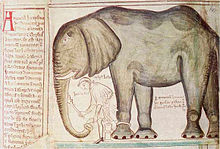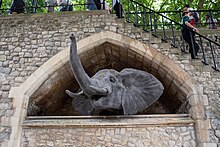Elephant of Henry III
[1] The elephant seems to have arrived in Europe as a result of Louis IX of France's Seventh Crusade, which began in 1248 with an expedition to Egypt.
[2]: 2 In November and December 1254 Henry III, travelling through France on his return from Gascony to England, met Louis at Orleans and Paris.
[2]: 2 The elephant first appears in English records of 13 December 1254 when Henry, who was then travelling from Paris to England, appointed his clerk, Peter of Gannoc, as the animal's keeper.
Peter was dispatched to meet with the keeper of the Royal Menagerie, John Gouche, to arrange the transport of the elephant to England.
[2]: 3 The animal was the first elephant in England since those brought by Claudius in 43 AD for the Roman conquest of Britain and its arrival caused a sensation.
[4] The second drawing shows a more realistic trunk and depicts the animal's keeper, Henry de Flor, to provide an indication of scale.
This is contrary to the prevailing belief, introduced by the 4th-century AD Hexameron of Ambrose, that the animals had no knees and could not rise from the ground if they fell.
[2]: 4 In late 1255 the new sheriffs of London (it was an annual office) were ordered by the king to provide for the maintenance of the elephant and its keeper.
At this time a labourer made around 2d a day and £15 was considered sufficient to support a knight for a year[2]: 3 The order was renewed for the following term and the sheriffs claimed £16 13s 1d from September 1256 to 14 February 1257, when the elephant died.
It is not known if the king was intent on recovering the valuable ivory from the animal, planned to exhibit the bones as a curiosity or intended to reinter them.
Mediaeval bestiaries attributed faithful and gentle virtues to elephants and associated them with the Biblical paradise and the redemption of Christ.

